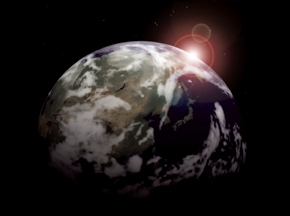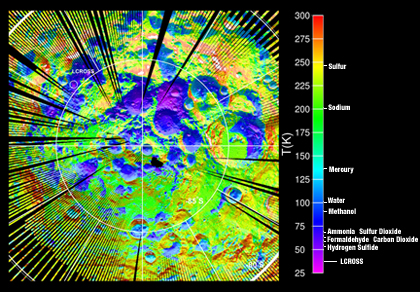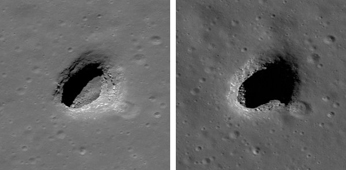Waxing Moon Exploration
The Lunar Reconnaissance Orbiter mission is re-energizing a possible manned return to the Moon
WHEN NASA’s Lunar Reconnaissance Orbiter blasted into space in June 2009, the mission was intended to be a first step toward extending human presence in the solar system, beginning with a return to the Moon.
But in February 2010, when President Obama cancelled Bush administration plans to return astronauts to the Moon by 2020, it seemed that the LRO mission had perhaps lost some of its luster.
On the contrary, reports Harlan Spence, EOS director and principal investigator of the Cosmic Ray Telescope for the Effects of Radiation (CRaTER) instrument onboard the spacecraft, the mission’s first year of work provided some rich discoveries that have helped – along with recent discoveries by other missions – give the Moon something of a facelift.
Our moon, it turns out, is not just a cold, barren, dusty orb. There are bucketloads of water down in craters and old volcanic tubes that could provide shelter from radiation – including a form discovered by CRaTER. The instrument measured a “backsplash” of protons coming off the Moon at nearly the speed of light in response to galactic cosmic rays slamming into the surface. This “particle albedo” is a sort of one-two punch of potentially deadly energy.
What’s more, for all practical purposes the Moon is the only extraterrestrial spot humankind will be (re)visiting anytime soon given the technological hurdles, staggering costs, and radiation risks posed by a mission to Mars (even for a one-way trip to the Red Planet, as has been in the news of late). So the more we know about our closest neighbor the better.
With that in mind, the LRO mission recently shifted from its “exploration enabling measurements” phase to one of pure scientific discovery as the orbiter circles the Moon’s poles.
Says Spence, “Our push to do the reconnaissance for manned exploration of the Moon eventually enables a lot of science. We’ve been authorized by NASA's Science Mission Directorate to conduct a two-year science investigation where all the instruments will continue operating pretty much as is but the focus will now be on analysis of the data for scientific results as opposed to exploration.”
This type of ionizing radiation not only presents biological hazards but can also have deadly effects on mechanical/electronic systems and lead to system failure. CRaTER’s measurements will provide invaluable information on radiation hazards even for future robotic missions to the Moon.
With respect to the additional radiation caused by the near-light-speed backsplash of protons, models show that the yield of that return radiation depends on what type of lunar material is getting bombarded by the cosmic rays – different types of rock, etc.
“We’re using CRaTER to probe the Moon and create maps using a technique that’s never been tried before,” notes Spence adding, “and we’re not just probing the visible surface. When these cosmic rays come in they can go down a meter or more and blast out subatomic particles from below, which like ground-penetrating radar allows you to potentially see features below the surface.”
In addition to all the practical engineering outcomes derived from the mission’s first year of exploration enabling measurements, those same data can now be used to better understand the geologic conditions over the lifetime of the Moon, its formation and possibly the formation of the Earth and other planets, and fundamentals of the Earth-Moon system.
“We’re taking the same set of measurements and making scientific discovery,” Spence says. “Being able to look at the surface globally at high resolution is causing us to fundamentally revisit the formation of early parts of our solar system, which is pretty exciting. It’s rewriting the textbooks.”
Indeed. During an October press conference celebrating agency missions, including LRO, that have “uncovered the Moon's buried treasures,” Michael Wargo, NASA’s chief lunar scientist, noted that these lunar explorations represent “one of many steps NASA has taken to better understand our solar system, its resources, and its origin, evolution, and future."
But in February 2010, when President Obama cancelled Bush administration plans to return astronauts to the Moon by 2020, it seemed that the LRO mission had perhaps lost some of its luster.
On the contrary, reports Harlan Spence, EOS director and principal investigator of the Cosmic Ray Telescope for the Effects of Radiation (CRaTER) instrument onboard the spacecraft, the mission’s first year of work provided some rich discoveries that have helped – along with recent discoveries by other missions – give the Moon something of a facelift.
Our moon, it turns out, is not just a cold, barren, dusty orb. There are bucketloads of water down in craters and old volcanic tubes that could provide shelter from radiation – including a form discovered by CRaTER. The instrument measured a “backsplash” of protons coming off the Moon at nearly the speed of light in response to galactic cosmic rays slamming into the surface. This “particle albedo” is a sort of one-two punch of potentially deadly energy.
What’s more, for all practical purposes the Moon is the only extraterrestrial spot humankind will be (re)visiting anytime soon given the technological hurdles, staggering costs, and radiation risks posed by a mission to Mars (even for a one-way trip to the Red Planet, as has been in the news of late). So the more we know about our closest neighbor the better.
With that in mind, the LRO mission recently shifted from its “exploration enabling measurements” phase to one of pure scientific discovery as the orbiter circles the Moon’s poles.
Says Spence, “Our push to do the reconnaissance for manned exploration of the Moon eventually enables a lot of science. We’ve been authorized by NASA's Science Mission Directorate to conduct a two-year science investigation where all the instruments will continue operating pretty much as is but the focus will now be on analysis of the data for scientific results as opposed to exploration.”
This type of ionizing radiation not only presents biological hazards but can also have deadly effects on mechanical/electronic systems and lead to system failure. CRaTER’s measurements will provide invaluable information on radiation hazards even for future robotic missions to the Moon.
With respect to the additional radiation caused by the near-light-speed backsplash of protons, models show that the yield of that return radiation depends on what type of lunar material is getting bombarded by the cosmic rays – different types of rock, etc.
“We’re using CRaTER to probe the Moon and create maps using a technique that’s never been tried before,” notes Spence adding, “and we’re not just probing the visible surface. When these cosmic rays come in they can go down a meter or more and blast out subatomic particles from below, which like ground-penetrating radar allows you to potentially see features below the surface.”
In addition to all the practical engineering outcomes derived from the mission’s first year of exploration enabling measurements, those same data can now be used to better understand the geologic conditions over the lifetime of the Moon, its formation and possibly the formation of the Earth and other planets, and fundamentals of the Earth-Moon system.
“We’re taking the same set of measurements and making scientific discovery,” Spence says. “Being able to look at the surface globally at high resolution is causing us to fundamentally revisit the formation of early parts of our solar system, which is pretty exciting. It’s rewriting the textbooks.”
Indeed. During an October press conference celebrating agency missions, including LRO, that have “uncovered the Moon's buried treasures,” Michael Wargo, NASA’s chief lunar scientist, noted that these lunar explorations represent “one of many steps NASA has taken to better understand our solar system, its resources, and its origin, evolution, and future."
by David Sims, Science Writer, Institute for the Study of Earth, Oceans, and Space. Published in Fall 2010 issue of EOS .


